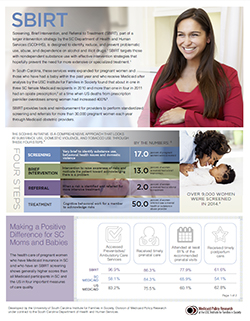 Screening, Brief Intervention, and Referral to Treatment (SBIRT), part of a larger intervention strategy by the SC Department of Health and Human Services (SCDHHS), is designed to identify, reduce, and prevent problematic use, abuse, and dependence on alcohol and illicit drugs.1 SBIRT targets those with nondependent substance use with effective intervention strategies that hopefully prevent the need for more extensive or specialized treatment.1
Screening, Brief Intervention, and Referral to Treatment (SBIRT), part of a larger intervention strategy by the SC Department of Health and Human Services (SCDHHS), is designed to identify, reduce, and prevent problematic use, abuse, and dependence on alcohol and illicit drugs.1 SBIRT targets those with nondependent substance use with effective intervention strategies that hopefully prevent the need for more extensive or specialized treatment.1
.In South Carolina, these services were expanded for pregnant women and those who have had a baby within the past year and who receive Medicaid after analysis by the USC Institute for Families in Society found that about in one in three SC female Medicaid recipients in 2010 and more than one in four in 2011 had an opiate prescription2 at a time when US deaths from prescription painkiller overdoses among women had increased 400%.3
More than 9,000 women were screened in 2014.4 The health care of pregnant women who have Medicaid insurance in SC and who have an SBIRT screening shows generally higher scores than all Medicaid participants in SC and the US in important measures of care quality that include access to preventative/ambulatory care services and timely prenatal care.
To read more about South Carolina’s SBIRT Initiative and the findings among SC Medicaid enrollees, download the pdf infographic here.
Notes:
1 Department of Health and Human Services Centers for Medicare & Medicaid Services. Screening, Brief Intervention, and Referral to Treatment (SBIRT) Services. Retrieved from http://www.cms.gov/Outreach-and-Education/Medicare-Learning-Network-MLN/MLNProducts/downloads/SBIRT_Factsheet_ICN904084.pdf
2 Lòpez-DeFede, A., Harris, T., Blanco-Silva, K., & Walker, D. (2012, Sept 12). Women of childbearing age and opioids: Preliminary data SC Medicaid Program. Retrieved from https://www.scdhhs.gov/sites/default/files/BOI%20Opiates_PreNatal%20Sept%2012_2012.pdf
3 Centers for Disease Control and Prevention. (2013, July). CDC Vitalsigns: Prescription Painkiller Overdoses. Retrieved from http://www.cdc.gov/vitalsigns/PrescriptionPainkillerOverdoses/index.html
4 Percentages represent data for state fiscal year 2014 (July 1, 2014 – June 30, 2015).